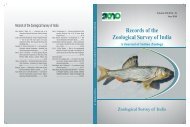Vol. 111 - Part I - Zoological Survey of India
Vol. 111 - Part I - Zoological Survey of India
Vol. 111 - Part I - Zoological Survey of India
Create successful ePaper yourself
Turn your PDF publications into a flip-book with our unique Google optimized e-Paper software.
Rec. zool. Surv. <strong>India</strong> : <strong>111</strong>(<strong>Part</strong>–1) : 11-16, 2011<br />
REDESCRIPTION AND NEW DISTRIBUTIONAL RECORDS OF OREUMENOIDES<br />
EDWARDSII (DE SAUSSURE) (HYMENOPTERA : VESPIDAE; EUMENINAE)<br />
FROM INDIA<br />
P. GIRISH KUMAR<br />
<strong>Zoological</strong> <strong>Survey</strong> <strong>of</strong> <strong>India</strong>, M-Block, New Alipore, Kolkata, West Bengal-700 053, <strong>India</strong><br />
E-mail : kpgiris@gmail.com<br />
INTRODUCTION<br />
Though relatively more taxonomic works on the<br />
potter wasps have been done on the fauna <strong>of</strong> Palaearctic<br />
and Nearctic regions, our information on the fauna <strong>of</strong><br />
<strong>India</strong>n subcontinent is very scanty and fragmentary.<br />
Among the species reported from <strong>India</strong> many need<br />
detailed taxonomic revision and redescription. One such<br />
species is Oreumenoides edwardsii (de Saussure), first<br />
described by de Saussure in 1852 as Eumenes edwardsii<br />
from Bombay. The species was described on the basis<br />
<strong>of</strong> a female (Habite: “Les Indes Orientales; le Bombay”).<br />
Original description was very short which is inadequate<br />
for the identification at species level. Subsequently<br />
Bingham (1897) provided a redescription <strong>of</strong> it which is<br />
also very short and with some errors in description<br />
such as : (1). Median segment (= Propodeum) smooth,<br />
slightly pubescent (Actually, dorsal side <strong>of</strong> propodeum<br />
closely and densely punctate with small silvery white<br />
pubescence and in between moderately large silvery<br />
white pubescence and lateral sides <strong>of</strong> propodeum<br />
smooth, almost bare except at lower side with minute<br />
pubescence); (2). Clypeus about twice as long as broad<br />
(Actually, the minimum width <strong>of</strong> clypeus is 0.86x its<br />
length medially); (3). The description <strong>of</strong> colour is also<br />
not provided in detail.<br />
In 1961 Soika erected a new genus Oreumenoides<br />
based on Eumenes edwardsii as the type. The other<br />
diagnostic characters <strong>of</strong> the genus are : male antennal<br />
apex minute, not hooked apically; petiole more than<br />
1.25x the length <strong>of</strong> mesosoma; second gastral tergum<br />
without lamella separated by preapical thickening;<br />
pronotum with pretegular carina. This Oriental genus<br />
is represented only by the type species Oreumenoides<br />
edwardsii (de Saussure) till date.<br />
O. edwardsii is so far known from Mumbai (in<br />
Maharashtra) (de Saussure,1852; Bingham, 1897),<br />
Dehradun (in Uttarakhand) (Gupta, 1995), Malampuzha<br />
(in Kerala) and Karad (in Maharashtra) (Gusenleitner,<br />
2006), North West Province (in Pakistan), Burma (=<br />
Myanmar) and Tenasserim (in Myanmar) (Bingham,<br />
1897), Sikkim; Satara district, Bombay Presidency;<br />
Calcutta; Kumdhik, Nepal Terai; Pusa; Gorakhpur;<br />
Trichinopoly (= Thiruchirapally in Tamil Nadu) (Dover<br />
& Rao, 1922) and from Thailand (Zipcodezoo.com<br />
Webpage). In the present paper, this species is<br />
redescribed and newly recorded from the <strong>India</strong>n states<br />
Delhi, Jharkhand, Karnataka, Madhya Pradesh and<br />
Rajasthan and the Union territory Pondicherry.<br />
MATERIAL AND METHODS<br />
This study is based on a number <strong>of</strong> unidentified<br />
specimens present in the Hymenoptera Section <strong>of</strong><br />
<strong>Zoological</strong> <strong>Survey</strong> <strong>of</strong> <strong>India</strong>, Kolkata (NZSI). All the<br />
specimens were set-pinned and dried. Male genitalia<br />
were dissected from one specimen collected from<br />
Namkum, Ranchi. Genitalia were dissected, treated with<br />
hot KOH, washed, dehydrated through grades <strong>of</strong><br />
alcohol and mounted on card. The specimens were<br />
studied under a stereozoom microscope (Wild<br />
Heerbrugg made in Switzerland) and drawings were<br />
made using the drawing tube <strong>of</strong> microscope.<br />
All the studied specimens were properly registered<br />
and kept at the ‘National <strong>Zoological</strong> Collections’ <strong>of</strong> the<br />
Hymenoptera Section <strong>of</strong> the <strong>Zoological</strong> <strong>Survey</strong> <strong>of</strong> <strong>India</strong>,<br />
Kolkata (NZSI).<br />
The following abbreviations are used in the text: F<br />
= Female; M = Male; MP = Museum National d’Histoire<br />
Naturelle, Paris; NZSI = ‘National <strong>Zoological</strong> Collections’<br />
<strong>of</strong> the Hymenoptera Section, <strong>Zoological</strong> <strong>Survey</strong> <strong>of</strong> <strong>India</strong>,
















